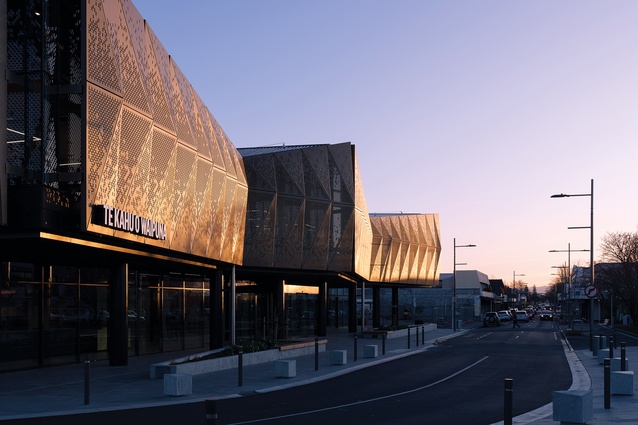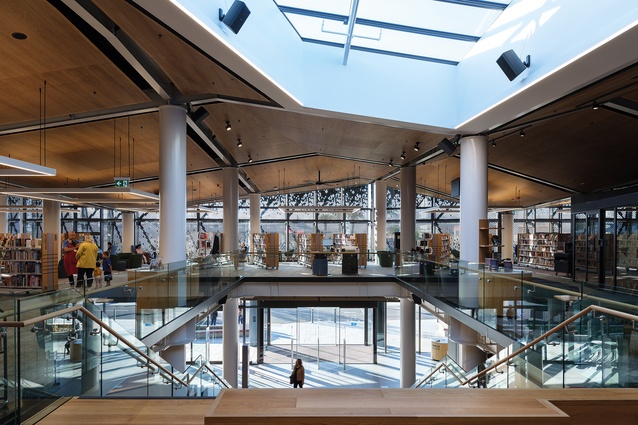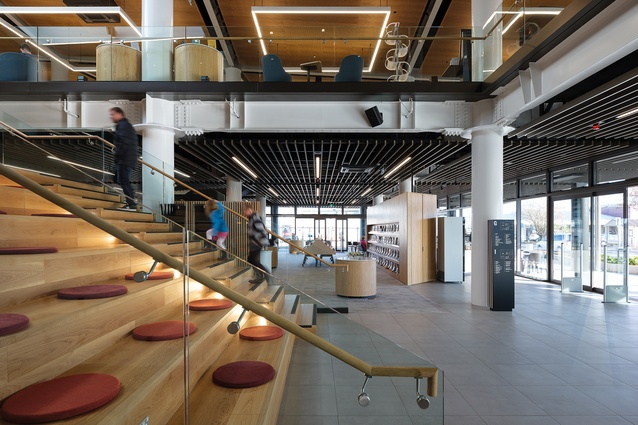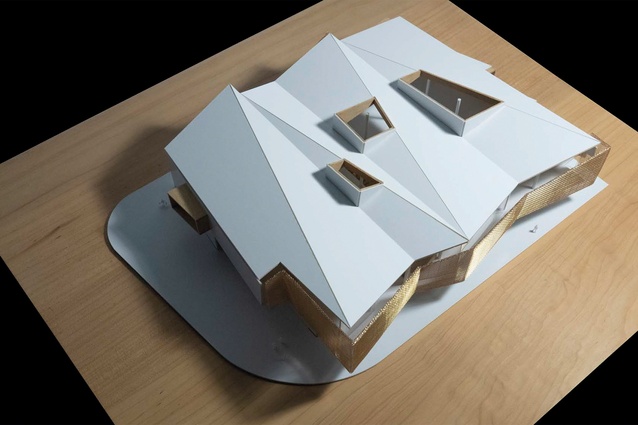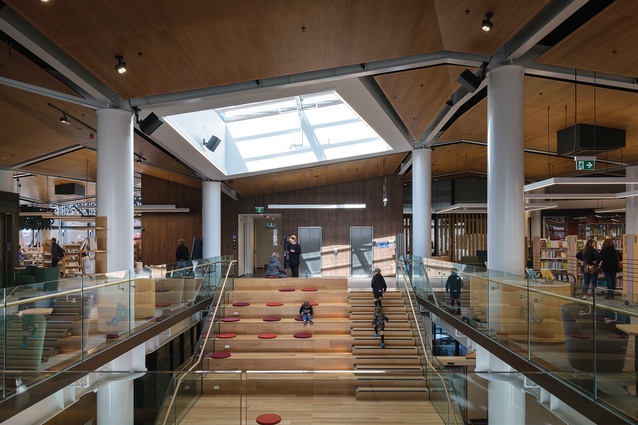Suiting up
Jeremy Smith investigates a new fashion statement in Blenheim’s combined library and art gallery, Te Kahu o Waipuna by Warren and Mahoney.

Architecture doesn’t arrive all at once. There’s a lot to unpack and hang, ribbons to cut, names to gift. Such welcoming celebrations are important for community, yet it is worth reflecting that we rarely wear the same wardrobe from one event to another while increasingly asking buildings to dress for a multitude of functions. As sustainable programming catalogues a whole new look, we can’t forget what we are packaging.
In our bigger cities, public buildings regularly standalone in their individuality; library can dress as library, gallery as gallery. But such finery isn’t so readily available in provincial centres where the freeflowing often mix and match with other straighter attires. All sorts of outfits seem to be racked together. Libraries with council receptions seem the fashion, no doubt thanks to the social servicing skills they provide.
Somehow, art galleries avoid the messier overtones that come with sorting out why the rubbish hasn’t been collected — presumably through not yet lending out artworks like books and other bedside reading essentials, like power tools.

Take the question architecturally to the boxing and it’s clear not everything can or should work with everything under a single roof. That’s a mall, and worthy of an oh-so-last-year eye roll or, worse, if you look around post-Covid America.¹ It is amongst these discussions of what goes with what that Warren and Mahoney collates Blenheim’s library and art gallery together within the new shared building: Te Kahu o Waipuna.
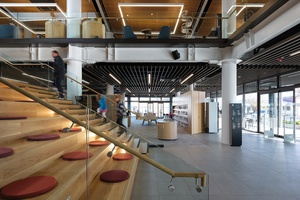
Cultural expression is important and Blenheim, remarkably, didn’t have an art gallery until this century. Blenheim is also a town where you can get lost vernacular op shopping. Well, I did and, after arriving before the building had been added to Google Maps, I needed directions. “It’s down there, past Farmers. It’s the one with big glass walls.”
The directions beautifully befit almost any of our town centres and the critique confidently labels a local, regionalist concern for any new arrivals. There it is, elbowing out a little at the end of the street. Turns out I’m not that early, for the building is now wearing a freshly cut and sharply ironed suit with stylish perforations. What’s more, there’s people enjoying it.
In true provincial style, I could have parked outside. The building occupies the fringe between the town centre and the river. It’s immediately opposite a large car park, which isn’t quite a piazza with all that kerbing but it is open and connects to Studio Pacific Architecture’s recent river-revival work.² Here, with all sides on show, the new art gallery and library mannequin their new shared attire.

To the north, the upper level overhangs the lower and provides street shelter opening onto High Street. The screening sleeves east around the corner to a profiled metal cladding before hemming out service-style to the south. The dressing then returns to the west, where the building stands off an empty western site, to, hopefully, as architect Richard McGowan suggests, fashion some kind of response in its upcoming neighbours. There’s a bit of crinoline to support all these screens but the cantilevering, screening and colonnading is important for it’s a beautifully tough climate here. Like all good overcoats, there’s a bit of couter armouring the couture.³
Those screens shape a ‘brown on brown’ protective layer — what McGowan describes as “versions of the same colour behaving differently under bright [Marlborough] light”. This abstraction to the surrounding and perennially barren hills also works to veil, but not hide, what’s going on inside. It’s all part of attracting more than just the usual suspects.
There’s an unusual in the usual, a “familiar in the unfamiliar” as McGowan puts it, that overlocks the library and gallery together and out into the public realm. With it, comes some good people-watching and those having coffee under the colonnade sport a wonderful mix of wardrobes — from Swanndri to Marc Jacobs — all inspecting the new arrival and happily heading inside. “Clothes mean nothing until someone lives in them,”4 Jacobs once said. You need the bones to hang clothes and make architecture and it is here that Warren and Mahoney questions what goes with what to make a building.
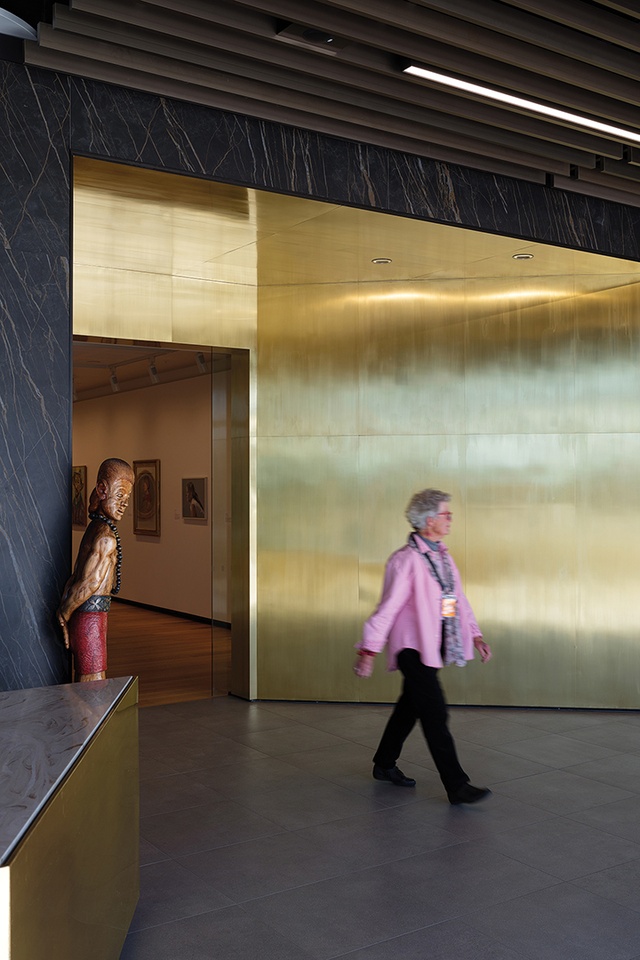
Library and art gallery spaces are different: think unfixed and affixed, unclosed to enclosed, unconditioned then conditioned. The architects navigate these complexities with what they call a “loose fit”. Rather than just squeeze everything in, they work to unplace the elements that provide the planning and sizing complexity. They adjoin and order things such that they cleverly make things a little roomy without upsizing or losing their tailoring. The result is that, while getting to where you are going is “not necessarily obvious”, it’s certainly “far from confounding”.
Logical. McGowan traces this legible approach to space-planning back to informative public buildings of Miles Warren and to a five-year period working with Patrick Clifford, between 1998 and 2003. There’s a directness to all this. The guy in the Swanndri arrives back with books under his arm and tells me to go see the Threads of Whātonga exhibition, so in I go.
I could have chosen an entry through a range of perimeter glass sliders or an after-hours entry, or even gone straight from the café where I’ve been sitting. But I make my entry through the main windbreak doors from the northern colonnade, which aims me straight at a grandstand stair. Enclosed gallery spaces are to the left, accessible library spaces to the right, and shared spaces, like meeting rooms and bathrooms, bustled out the back.

The gallery works in a series, linking the northern counter to the gallery, through back-of-house workspaces and archiving, and out to a southern loading dock. On the walls is a growing collection of national artists, informed by and informative to the region: Peter McIntyre in the Awatere Valley, Don Binney in Kenepuru Sound, JS Parker who may be the known artist stemming from the region, and those like John Pule brought to foster discussion with local communities. Fuelled with pictures, I go for a read.
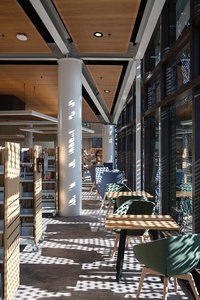
The library runs an equally logical assembly. Computers and large print are at street level, with the majority of the collection and reading areas up easy-to-find stairways. If the lower plan has the odd elbow, the upper plan and its roofing is more like a Lisa Simpson hairdo.
Behind those faceting screens is an ‘elevated room with a view’: an almost singular, large space running stacks to individual seating, enjoying the perimeter glazing and filtered light from those perforations. Head to the corners and, as the screens split and the view opens, the reading spaces broaden with youths.
The structure supports this logical planning through a regular grid without diagonal bracing and by extending timber ceiling spacings out to soffits. Natural ventilation intakes use all those entry door options to simplify the mechanical to spot conditioning.
With the space free from fixed accessories, material linings and finishes simply inlay a welcoming take on current interiors. We might imagine the trimming of external space out there in the perforations and the inevitable red-penning that comes with shovelling large cantilevers and any kind of screening within the demands of the Provincial Growth Fund. No matter: there’s more to the thinking here than digging into such economies.
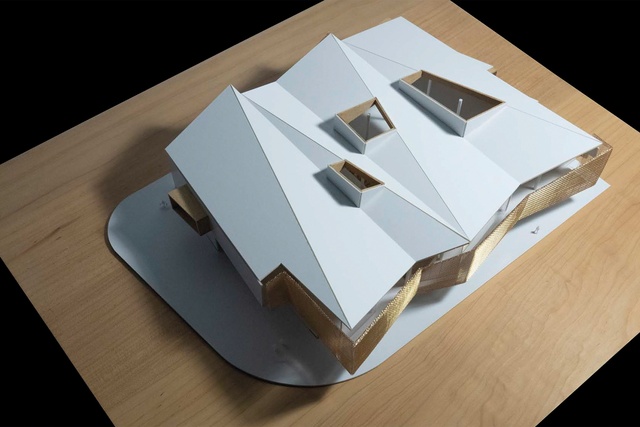
The beauty of architecture is that we all tailor it in different ways and the wardrobes of our communities are the winners. Warren and Mahoney’s loose fitting signals a way of undressing any reliance on either couter or couture in the teaming up of facilities within public buildings. It’s a valid and timely reminder to the public pairing of expressions rather than logistics and to planning out what’s underneath before labouring the vernacular. Beneath the joys of the suit, Warren and Mahoney puts forward a straight and navigable plan that is free in its outcome.
It’s more direct than Yvonne Farrell and Shelley McNamara’s 2018 Biennale free-spacing. 5 They cut their seams and don’t free-form from programme as might an OMA library. 6 Nor do they play Renzo Piano gallery gymnastics and free-light a single Menil detail. 7 But this isn’t Venice, Seattle, Houston or even Rotterdam, for you can’t yet borrow power tools, I’m told. The fit here arrives just where McGowan and team intended it to be and is clearly legible to Blenheim life. It may yet invite a shared laneway: perhaps a piazza?
Fashion leads fashion after all. Architecture can do that. Go visit. Like the provinces, it’s a good place to be. Wear whatever you like. Warren and Mahoney is wearing a brown suit.
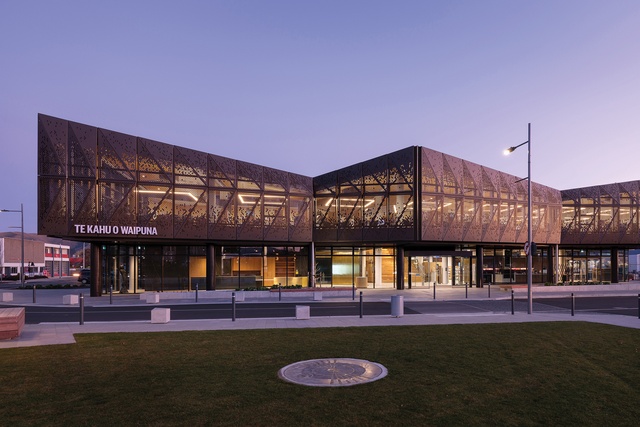
REFERENCES
1 Pamela N Danziger, ‘How to Bring ‘Zombie Malls’ Back to Life’, Forbes. 20 March 2023.
2 ‘Winners revealed: 2020 Nelson/ Marlborough Architecture Awards’, ArchitectureNow. 15 July 2020.
3 The couter is the defense for the elbow in a piece of plate armour.
4 Harper’s Bazaar. 4 February 2022.
5 Miriam Sitz, ‘Yvonne Farrell and Shelley McNamara of Grafton Architects Win 2020 Pritzker Prize’, Architecture Record. 3 March 2020.
6 Witold Rybczynski, ‘Revisiting Rem Koolhaas’s Central Library and Peter Bohlin’s City Hall in Seattle’, Architect. 22 April 2013.
7 John Puttick, ‘Great Detail: John Puttick on Piano’s Menil Collection Roof’, Architects’ Journal. 7 December 2016.



